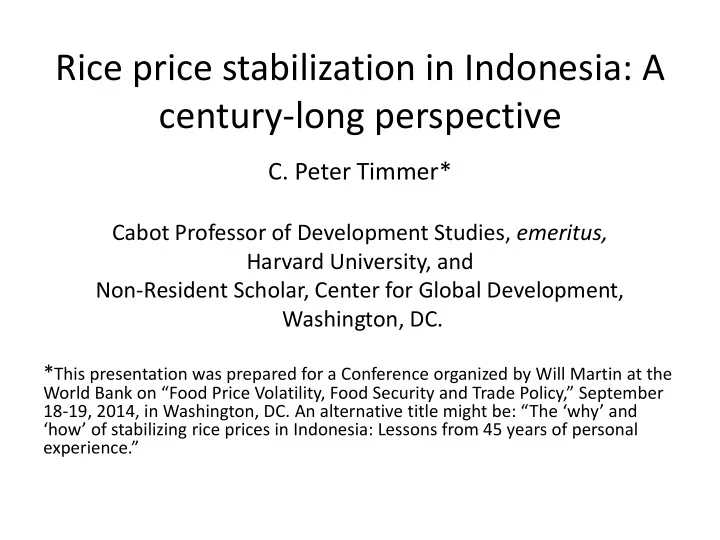

Rice price stabilization in Indonesia: A century-long perspective C. Peter Timmer* Cabot Professor of Development Studies, emeritus, Harvard University, and Non-Resident Scholar, Center for Global Development, Washington, DC. * This presentation was prepared for a Conference organized by Will Martin at the World Bank on “Food Price Volatility, Food Security and Trade Policy,” September 18-19, 2014, in Washington, DC. An alternative title might be: “The ‘why’ and ‘how’ of stabilizing rice prices in Indonesia: Lessons from 45 years of personal experience.”
I. Rice in Asia A. History, culture, economics and politics B . “Rice is different,” but Indonesia is the same C. The Asian pattern: Active policy to stabilize rice prices and rising protection during structural transformation D. Instability in the (residual) world market, both cause and effect of domestic policies
II. History of rice price stabilization A. The Dutch era: Defending colonial interests while stabilizing rice prices B . Under the “guided economy” of Sukarno: not much stability or investment C . The “New Order” of Suharto takes stabiliza- tion seriously; BULOG becomes a key player D. Price stabilization in a democratic and decentralized environment
III. Why have stable rice prices been so important in Indonesia? A. Rice in the domestic economy: “ Rice is the barometer of the economic situation in Indonesia” according to Harian Kami (1967) 1. Production (unstable due to weather/pests; but much more stable than world prices) 2. Marketing (90% private sector) 3. Consumption (goal is steady on trend) 4. Rural versus urban interests: Who matters (and when does this change?)
B. The politics of rice 1. Stable rice prices equals stable political systems 2. Authoritarian versus democratic perspectives (not as different as you might think) 3. What do “voters” want? How do they get it? Political market? 4. Stable rice prices as a public good
C. Structural transformation and the loss of competitiveness in agriculture 1. In agriculture broadly, but in rice specifical- ly (very labor intensive) 2. World market unreliable (political percep- tions and historical facts) 3. Stable rice prices in domestic currency plus an appreciating currency equals rising protec- tion for domestic producers, especially when dollar prices in world markets are falling (pro- tection was not the POLICY choice until 2006)
IV. Can rice prices be stabilized domestically? A. What prices, where and for how long? 1. Major urban markets 2. Jakarta matters: It was the only city where price statistics were collected from 1951 to 1966 3. Do countries “outgrow” their need to stabilize rice prices? No evidence from Asia that they do… (see Figure 1)
2012 rupiah per kg 10000 12000 14000 16000 2000 4000 6000 8000 0 Jan-69 Figure 1: Indonesian and world rice prices, in Rp Mar-70 May-71 Jul-72 Sep-73 Nov-74 Jan-76 Mar-77 May-78 Jul-79 Sep-80 Nov-81 Jan-83 Mar-84 May-85 Jul-86 Domestic Sep-87 Nov-88 Jan-90 Mar-91 May-92 World Jul-93 Sep-94 Nov-95 Jan-97 Mar-98 May-99 Jul-00 Sep-01 Nov-02 Jan-04 Mar-05 May-06 Jul-07 Sep-08 Nov-09 Jan-11 Mar-12 May-13 Jul-14
2013 rupiah per kg 10,000 12,000 14,000 16,000 2,000 4,000 6,000 8,000 0 Jan-69 Nov-70 Sep-72 Jul-74 May-76 Mar-78 Jan-80 Nov-81 Domestic Sep-83 Jul-85 May-87 Mar-89 World Jan-91 Nov-92 Sep-94 Jul-96 World (USD) May-98 Mar-00 Jan-02 Nov-03 Sep-05 Jul-07 May-09 Mar-11 Jan-13 0 500 1,000 1,500 2,000 2,500 3,000 2013 USD per ton
B. An evolving model of rice logistics for stabilizing prices 1. Imports to inject into urban wholesale markets 2. Domestic procurement to support a farm-level floor price: Incentive to adopt Green Revolution technology and use fertilizer 3. A logistical agency to manage seasonal price formation via procurement, storage of buffer stocks, and distribution to urban markets
B. An evolving model (continued) 4. Imports as the balance wheel: At what price? This is the KEY conceptual, financial and political problem 5. BULOG’s logistical operations: 25 years of stabilizing rice prices (see Table 1) 6. “Privatization” and blurred roles 7. The chaos of a macro crisis: 1998
V. What goes wrong? A. Seasonal margins are too narrow; expensive to defend B. Prolonged mis-alignment with world prices (what is the right trend? — always backward looking) C. Need for flexible budget for procurement, but a big share of financial credit D. Self-sufficiency is VERY hard to manage — a BIG disconnect between this and food security E. Corruption (any time there are significant price wedges — the ultimate downfall of stabilization programs). Not inevitable, but hard to control.
VI . Is there an “efficient” way to stabilize domestic rice prices? A . Recognize the behavioral foundations of the demand for stable rice prices. This demand can only be expressed in political “markets,” making price stability a public good. Politicians under- stand this: if economists do not, they are irrelevant. B. Can price stability be offered by the private sector if individual firms (supermarkets) have a large enough market share? Can supermarkets (and their modern supply chains) be “too influential?” Big question in Asia.
C. Trade as the balance wheel, but controlled by logistical operations or trade policy 1. Transparent domestic price objectives 2. Efficient logistics for imports 3. Gradual move toward more competitive domestic rice production and marketing, thus needing less protection 4. Implied diversification of agriculture to follow new dietary patterns
D. Smaller role for BULOG 1. Wider margins permit less active role in physical logistics (but more adjustment by consumers) 2. Larger role for a competitive private sector, including managing imports 3. But this requires a larger role in analysis, design, monitoring and evaluation (and perhaps more sophisticated regulation of the food marketing sector: food safety issues)
VII. Concluding observations A. How to make rice a less “political” commodity B . How to be a “good actor” in arranging imports C. How to design rice price policy with fewer incentives for corruption, but still within a stabilization mandate (on the agenda…) C. Better data; better analysis; better policy; better results
Recommend
More recommend